Saluran C Strut
-

Profil pemasangan 41*41 saluran strut / saluran C / Braket Seismik
Strut Channel kasusun saka baja U-shaped utawa baja C-shaped digawe saka seng-aluminium-magnesium lan ndhukung aksesoris sambungan.Iku ora mung bisa gampang diangkut lan nglumpuk, nanging uga nduweni kaluwihan saka pangopènan gampang, urip dawa lan biaya ekonomi kurang.Iku indispensable kanggo stasiun daya photovoltaic.Salah sawijining aksesoris materi sing ilang.
-
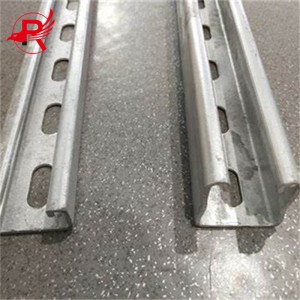
High Quality 4.8 Galvanized Carbon Steel entheng U Channel Slotted Metal Strut Channel
Ing babagan arsitektur lan konstruksi, nggawe struktur sing kuat lan dipercaya iku penting banget.Penting kanggo milih bahan lan komponen sing pas sing ora mung menehi kekuatan nanging uga menehi fleksibilitas ing desain.
-
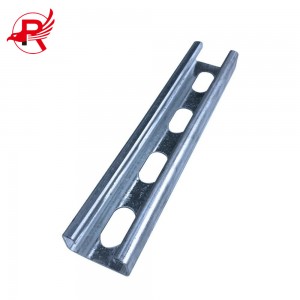
Cold Formed Structural Galvanized Slotted Steel C Channel krenjang Panel Surya Profil karo bolongan
Saben proyek konstruksi mbutuhake bahan sing kuat lan dipercaya kanggo njamin daya tahan lan umur dawa.Antarane macem-macem pilihan sing kasedhiya, C Channel Structural Steel lan Galvanized C Purlins steel ngadeg metu minangka pilihan populer kanggo kekuatan ngédap lan versatility.
-
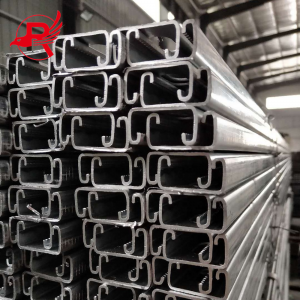
Hot Dipped Galvanized Steel Slotted Strut C Channel
Hot-dip baja galvanis slotted saluran support punika sistem support digunakake ing arsitektur, instalasi electrical lan mechanical.Iki digawe saka baja sing wis galvanis panas kanggo tahan korosi.Desain slotted ngidini lampiran gampang saka macem-macem komponen kayata pipo, conduits lan trays kabel nggunakake bolts lan perkakas.Saluran kirim jinis iki umume digunakake ing setelan industri lan komersial kanggo framing, instalasi peralatan, lan nggawe struktur dhukungan.Lapisan galvanis hot-dip nyedhiyakake daya tahan lan proteksi karat, saengga cocok kanggo aplikasi njero ruangan lan ruangan.
-
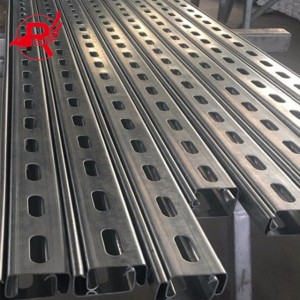
Pabrik Langsung Pasokan Slotted Galvanized Unistrut HDG Gi Strut C Channel Steel
Hot-dip baja galvanis slotted saluran support punika sistem support digunakake ing arsitektur, instalasi electrical lan mechanical.Iki digawe saka baja sing wis galvanis panas kanggo tahan korosi.Desain slotted ngidini lampiran gampang saka macem-macem komponen kayata pipo, conduits lan trays kabel nggunakake bolts lan perkakas.Saluran kirim jinis iki umume digunakake ing setelan industri lan komersial kanggo framing, instalasi peralatan, lan nggawe struktur dhukungan.Lapisan galvanis hot-dip nyedhiyakake daya tahan lan proteksi karat, saengga cocok kanggo aplikasi njero ruangan lan ruangan.
-

Baja Galvanis Zam310 S350GD Unistrut 41 X 21mm Saluran Slotted Tugas Ringan
Hot-dip baja galvanis slotted saluran support punika sistem support digunakake ing arsitektur, instalasi electrical lan mechanical.Iki digawe saka baja sing wis galvanis panas kanggo tahan korosi.Desain slotted ngidini lampiran gampang saka macem-macem komponen kayata pipo, conduits lan trays kabel nggunakake bolts lan perkakas.Saluran kirim jinis iki umume digunakake ing setelan industri lan komersial kanggo framing, instalasi peralatan, lan nggawe struktur dhukungan.Lapisan galvanis hot-dip nyedhiyakake daya tahan lan proteksi karat, saengga cocok kanggo aplikasi njero ruangan lan ruangan.
-
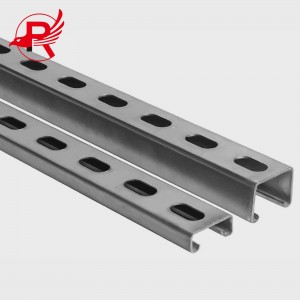
Hot Dip Galvanized Steel Slotted Strut Channel karo CE (C Channel, Unistrut, Uni Strut Channel)
Hot-dip baja galvanis slotted saluran support punika sistem support digunakake ing arsitektur, instalasi electrical lan mechanical.Iki digawe saka baja sing wis galvanis panas kanggo tahan korosi.Desain slotted ngidini lampiran gampang saka macem-macem komponen kayata pipo, conduits lan trays kabel nggunakake bolts lan perkakas.Saluran kirim jinis iki umume digunakake ing setelan industri lan komersial kanggo framing, instalasi peralatan, lan nggawe struktur dhukungan.Lapisan galvanis hot-dip nyedhiyakake daya tahan lan proteksi karat, saengga cocok kanggo aplikasi njero ruangan lan ruangan.
-
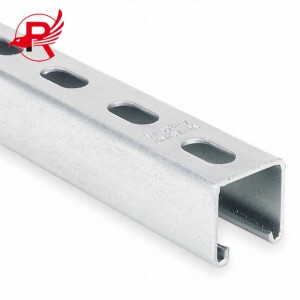
Pabrik Langsung Pasokan Slotted Galvanized Strut Channel Steel Unistrut HDG GI Strut C Channel Steel
GI C Channel nuduhake sistem dhukungan struktural sing umum digunakake ing aplikasi konstruksi lan industri."GI" ing jeneng stands for wesi galvanis, nuduhake yen baja dilapisi karo lapisan seng kanggo nyegah karat.Jeneng "baja berbentuk C" nuduhake wangun profil baja, sing meh padha karo huruf "C."Wangun iki menehi kekuatan lan kaku nalika ngidini gampang lampiran komponen liyane.GI C-Channels umume digunakake kanggo pigura, ndhukung lan ngamanake macem-macem komponen bangunan lan sistem kayata conduits, pipa, tray kabel lan Unit HVAC.Iki dirancang karo slot lan bolongan kanggo gampang lampiran fasteners, krenjang lan hardware liyane, nggawe solusi Versatile lan adaptasi kanggo dhukungan struktural lan kabutuhan instalasi.Lapisan galvanis nambah daya tahan lan resistensi faktor lingkungan, nggawe Saluran GI C cocok kanggo aplikasi njero ruangan lan ruangan.
-
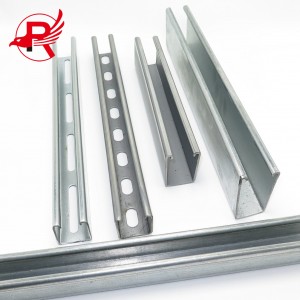
Saluran Galvanized Solid Lan Slotted Channel Black 41 × 41 Slotted Steel Unistrut Channel
saluran baja Slotted, uga dikenal minangka saluran strut utawa saluran pigura logam, umume digunakake ing construction lan setelan industri kanggo ndhukung, pigura lan ngamanake macem-macem komponen bangunan lan sistem.Saluran iki biasane digawe saka baja lan dirancang karo slot lan bolongan kanggo nggampangake lampiran fasteners, kurung, lan hardware liyane.Saluran baja grooved teka ing macem-macem ukuran lan kekandelan, nggawe cocok kanggo macem-macem aplikasi kayata conduits ndhukung, pipa, sistem tray kabel, unit HVAC, lan komponen mechanical lan electrical liyane.Padha asring digunakake kanggo nggawe pigura kanggo soyo tambah lan ngatur peralatan lan perlengkapan, nyediakake solusi Versatile lan customizable kanggo dhukungan struktural lan kabutuhan instalasi.
-
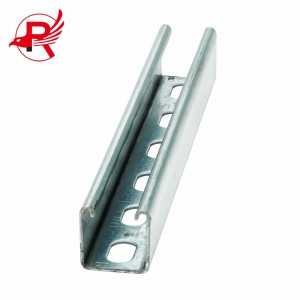
Double Unistrut Channel Mild Steel Unistrut Galvanized Steel Strut Channel
Saluran dhukungan baja galvanis umume digunakake kanggo ndhukung, pigura lan ngamanake macem-macem konstruksi lan komponen industri.Saluran kasebut digawe saka baja galvanis lan dilapisi lapisan seng kanggo nyegah karat lan nambah daya tahan.Saluran kirim dirancang karo slot lan bolongan kanggo gampang masang fasteners lan aksesoris, saéngga kanggo panginstalan fleksibel lan customizable.Digunakake kanthi akeh ing aplikasi listrik, mekanik lan struktur kanggo ndhukung saluran, pipa, kabel lan peralatan liyane.Lapisan galvanis nyedhiyakake perlindungan tambahan marang kahanan lingkungan sing atos, nggawe saluran pilar kasebut cocog kanggo panggunaan njero ruangan lan ruangan.
-
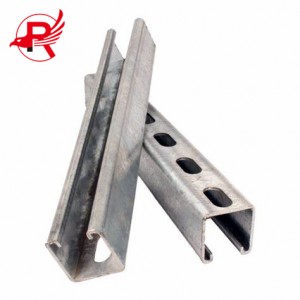
Produsen China Unistrut Strut C Channel Profil Strut Channel
Saluran Dhukungan C-Channel umume digunakake ing aplikasi konstruksi lan industri kanggo ndhukung kabel, pipa, lan peralatan liyane.Saluran iki digawe saka logam (biasane baja utawa aluminium) lan dirancang kanthi bagean salib C-shaped kanggo nambah kekuatan lan kaku.Desain ngidini kanggo instalasi gampang lan keluwesan ing soyo tambah macem-macem komponen.Saluran strut saluran C asring digunakake ing kombinasi karo fitting lan fitting kanggo nggawe struktur dhukungan khusus kanggo macem-macem jinis peralatan lan sistem.
-
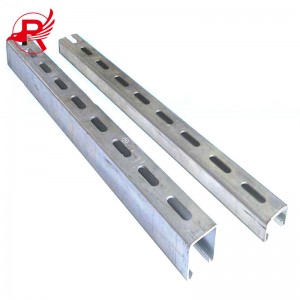
Supplier Quality Industrial Metal Galvanized Strut lan Steel Channel
Nalika nerangake mbangun bangunan sing kuat lan dipercaya, milih bahan bangunan sing tepat iku penting.Antarane akeh pilihan sing kasedhiya, C-Channel Structural Steel stands metu minangka pilihan Versatile lan populer.Ing antarane macem-macem jinis C Purlins, kita bakal fokus khusus ing varian galvanis amarga daya tahan lan kekuatan sing luar biasa.
